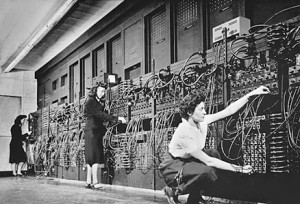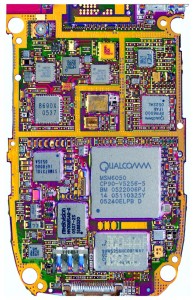
During World War II college-educated women were recruited to do the complex calculations needed for the trajectories for the military’s weapons.
It is often difficult to get a perspective on how much things change. The technology culture of 1945 almost seems a different universe from the culture technology is creating today. Computers are enabling amazing things, impossible things, to become possible. People complain that technology today is too complex, that talking to computers requires too much of a deviation from our natural communication behaviors. I think they are right.
But in 1945, talking to the first computers was easy. They were people. Being a “Computer” was a job, not a machine. We named the machines after the people. And some of our most important “Computers” were women who liked math. In fact, they were very good a math. The United State recruited women to be “Computers” to help with World War II. In the 1940’s computers, as we know them, didn’t exist. When the Army or Navy fired their big canons, they needed to know where the shell would land. Women “Computers” created tables for soldiers to use to figure out what angle to aim the canon. When we were trying to build the atom bomb, women did the detailed complex calculations to determine how to start a nuclear reaction and what would happen. Most importantly, when we finally did build the first computer, the ENIAC, it was these women “Computers” that taught ENIAC how do these calculations. Women were our first computer programmers.
The first computer was the ENIAC. In was developed in 1946 at Princeton University. It was big, loud and proud, so to speak.
It cost about $6,000,000
It was about 8 feet high, 3 feet deep, and… 80 feet long
It weighed 30 tons!
It used a lot of power and it was very hot!
And… it was down half the time to replace vacuum tubes gone bad.
The ENIAC weighed about as much as all the students in an average middle school altogether!
The cell phone is the most common computer that most of us carry around. You may not think of it as a computer, but the functionality is enabled by multiple computers working together. The cell phone is something the designers of the ENIAC could never have imagined. Just getting the ENIAC working took everything they had. The designers of the ENIAC were heckled by some of their colleagues saying that ENIAC was a waste of time and would never work. I’m thinking they were wrong…
To the left is a cell phone mainboard. It is 1.5” x 2.5”. It has a couple of computers on it. If compared to the giant ENIAC:
It cost 17,000X less
It is 40,000,000X smaller
It uses 400,000X less power
It is 120,000X lighter
But…
It is 1,300X more powerful.
Is this the latest iPhone or Droid? NOPE, it is turn-of-the-century, run-of-mill, cell phone with texting, MP3, and 0.3 mega-pixel picture capabilities … and it was used on the Verizon network. “Can you hear me now”
It is not possible, but if this cell phone were made with ENIAC technology.
It would weigh more than all of the middle school students in the state of Florida and would require a small power plant to run it. How would you like that in your pocket?
A crazier comparison is to compare a cell phone to a person. Remember our human computers? If a human did all the computing needed by the cell phone, how would the cell phone compare?
It costs 350x less
it weights 480x less
It uses 280x less power
It weighs 700x less
and…
It is 12,960x faster
Computer chips are making things possible that no one dreamed of before. In the 1950’s, Thomas Watson, Chairman of IBM, thought that the world might only need 5 computers. Today there are billions and billions of computers.



